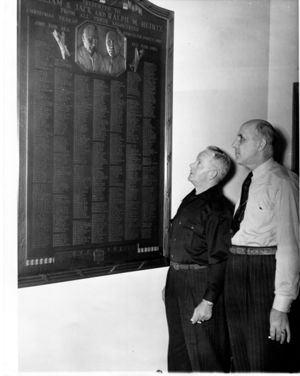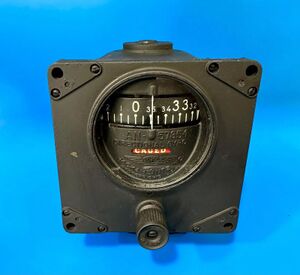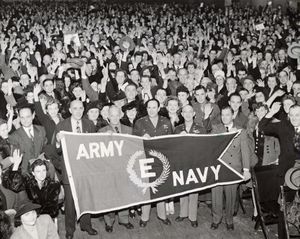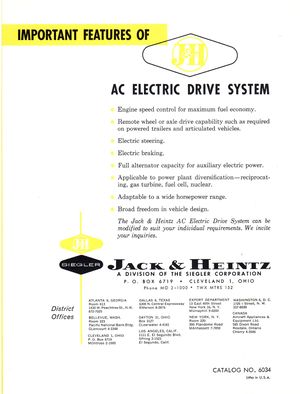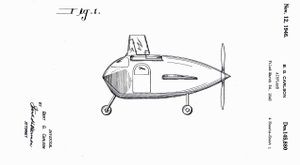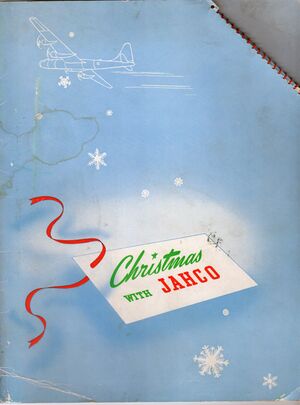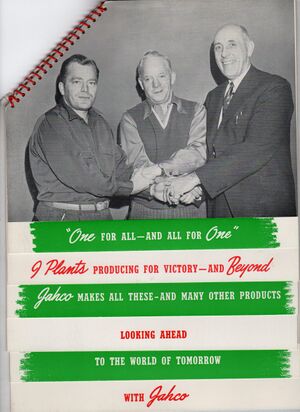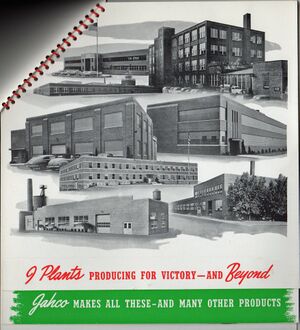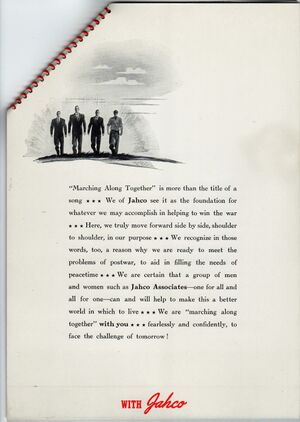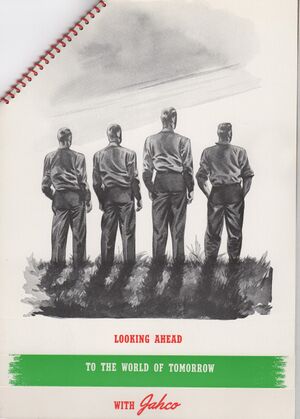Jack and Heintz
This is a sequel page to the Heintz and Kaufman pages.
Founding
In 1940 Wm. S. "Bill" Jack and Ralph M. Heintz founded the Jack and Heintz Co. in Palo Alto, CA.
Bill Jack was an experienced machinist while Ralph Heintz, for almost a decade, had been manufacturing radio transmitting tubes under the Heintz and Kaufman (H&K) - Dollar Co. partnership and supplying radio equipment for diverse applications as described in ethw.org/Heintz_and_Kaufman (ref1).
Clearly the two men came together at the right time, especially for Ralph Heintz. Up to this time, H&K had as its first large customer the Robert Dollar Co., one of the most profitable shipping companies in the world. The Dollar Co. used H&K Gammatron tubes in their communication systems. Dollar even acquired a controlling interest in H&K as has been documented in the excellent "How Silicon Valley Came to Be" (ref 2) but by 1938 the Dollar Co. was bankrupt and the US Maritime Commission took over the firm.
Furthermore, the expanding market for high power transmitting tubes would soon fall into favor of a small firm formed by two ex-H&K employees, William Eitel and Jack McCullough who left H&K in 1934 to start Eitel McCullough and within a few years Eimac would begin its rise to become one of the largest tube companies in the world.
Associated Press Photo 3/23/42 William S. Jack (left) president of Jack and Heintz, Inc. and Ralph Heintz, Vice President of a Cleveland Ohio Company manufacturing airplane parts, study the plaque they received from workers with whom they shared war contract profit last year. House Naval Committee was to study the .. (not readable). Clevelanders know the place as where workers lengthened working days, having lunch "on the house" and working to phonograph music. Jack says plant is way ahead of scheduled production.
The War Brings Opportunities
In his famous speech to Congress in May of 1940 (ref 3), President Franklin Roosevelt asked for $1.18B for funding a massive defense production act and in it he stipulated that it must include 50,000 new aircraft, an unheard of volume at a time when the economy was just coming out of the Great Depression. Clearly Bill Jack and Ralph Heintz saw an opportunity and acted quickly.
In "The Personnel Program of Jack & Heintz" author Roswell Ward describes what led up to the meeting between Bill Jack and Ralph Heintz in 1940.
Bill Jack had sold his controlling interest in PESCO Products, a $2M business in Cleveland that he had built, to the Borg-Warner Corp in 1939 but they allowed him to continue operating the business.
In 1939 Borg-Warner attempted to get Bill Jack to stop production at the PESCO Products business and fired him when he refused to quit.
Ralph Heintz had a contract to build equipment for the U.S. Army but he had been bought out by Bendix and they moved him to their plant in New Jersey in 1937. He didn't like the company and after a two year contract was up he left in frustration and went back to California.
Both men saw little future and wanted to get back into manufacturing under their own names.
Bill Jack traveled to Palo Alto to discuss with Heintz a possible business partnership and the two men formed Jack and Heintz Co. "JAHCO". Their first product was an aircraft starter motor. Mr. Jack had twenty five of his best machinists and their families move from Cleveland to California to fill a contract JAHCO received from Washington DC (most likely a result of President Roosevelt's request to Congress).
But, in October 1940, due to excessive demands by the local Machinists' Union in California, despite Mr. Jack having been a business manager for the same Union for almost 20 years, a strike was called. After neither side could meet half way, JAHCO packed up and moved the workers, their families and production equipment back to the Cleveland area.
Jack and Heintz Co. logo: (JAHCO) started up in a yet-to-be-completed building near Maple Heights, OH (link 6). From 37 employees in 1940 the company grew to 8700 by 1944, thanks to quick implementation of designs for aircraft starter motors.
JAHCO's Diverse Product Range
New military requirements added autopilots, flap actuators and other specialized parts.
For switching high current to starter motors JAHCO built relays for 24Vdc. They also made "starter energizers" (JH2300) that were used to spin up a flywheel on aircraft engines if starter motors were not present or non-operational. Lastly, JAHCO supplied rotary inverters that supplied power to radio communications gear and other equipment operating from 115Vac 400Hz.
One of the major contracts JAHCO won was for instruments used in aircraft control panels. In that category are Directional Gyro indicators, which were connected to equipment in the airframe to provide automated flight control, this helped reduce human error in navigation.
Notably was the A3-A autopilot system developed by the Sperry Corp. It used instruments such as the AN-5735 Gyro Turn Indicator and JAHCO’s model 6000, a so-called “Bank-Climb” indicator. Both JAHCO and Sperry Gyroscope Co. supplied these for nearly all US Army AF and US Navy aircraft during WWII. The A3-A operated by pneumatic sensors and provided automatic rudder control and was incorporated into B24C Liberators, B25 Mitchell and the P61 Black Widow aircraft as well as in transport planes including the C-46, C-47 and C-54.
The AN-5736 Gyro Horizon Indicator was another important instrument made by JAHCO. Directional Gyro indicators with their delicate pneumatic component parts were assembled and calibrated mostly by women, as can be seen in this archived movie of a JAHCO manufacturing facility in 1944.
JAHCO also designed and built small gasoline engines for WWII target drone aircraft and these engines were later used in Marman motorbikes (ref 4).
JAHCO employees were treated to free coffee, no-charge meals were brought in and, from a large library of LP records, music was played in the plant almost constantly while workers did 12-hour shifts 7 days a week. Bonuses were given to all workers evenly when deliveries were met and they often exceeded contractual completion dates. This is well-documented in the Case Western Reserve University's history on Lear Siegler (ref 5).
Mr. Jack didn't allow any discrimination and women were treated equally. JAHCO set an example for an organization built on benevolence and advanced workplace relations that hadn't been seen to this degree in any industry at that time and very few since.
Army E-Awards
A crowd of 10,000 celebrate the awarding of the Army-Navy Production (or "E") Award to the Jack and Heintz Company on December 23, 1942. The military presented these awards to over 4000 companies during World War II to encourage the fast and efficient production of war materials. JAHCO received four "E" Awards: on Dec 13, 1942, Sept. 4, 1943, Apr. 1, 1944 and Oct. 14, 1944.
Success Brings Changes
JAHCO reported a net profit of $4,185,560 for 1943. The company sold common and preferred shares and investors included many of the employees. Seeing the post-war slump, in 1945 an entity named Precision Products was formed to acquire Jack and Heintz Inc. On March 5, 1946 Precision Products acquired most of the outstanding shares of Jack & Heintz Inc. from taxpayers for $5M. On March 6th Precision merged its newly acquired subsidiary with itself and the name was changed to Jack & Heintz Precision Products.
The firm continued to work as it diversified, briefly making electric motors for industry in an attempt to compete with Industrial giants like General Electric and Westinghouse. Then, in 1961, it became the Power Equipment Division of Siegler Corp. and within a few months Siegler merged with Lear Avionics forming Lear Siegler Inc. (Ref 6 offline temporarily effective Jan 2023)
In the brochure "AC Electric Drive System" is described a solid state variable frequency drive "A new and exclusive ac concept in propulsion and auxiliary power for land, marine and amphibious vehicles".
Finally, in 1988 after some financial problems, the company was acquired by Britain's Lucas Aerospace Industries for $32.2M and relocated to Twinsburg, OH. Effective 2023 info shows the business is now the Safran Electrical Power division of Safran Group, the large French consortium.
Patents
Numerous patents were filed by Ralph Heintz, the most notable are the following:
2,330,121 Sept 21, 1940 Motor Cooling System (Heintz)
2,323,135 Feb 21, 1942 Hand Crank Mechanism (Heintz)
2,452,047 Oct 19, 1948 Engine Starting System (Heintz)
CA444170A Sept 16, 1949 Automatic Pilot Turn Rate Control (Heintz)
2,600,762 Aug. 4, 1952 Starter Generator (R.J. Hartz for J&H Precision Ind.)
A purely conceptual design for a small airplane was presented by Bert G. Carlson and assigned to Jack & Heintz Precision Industries March 24, 1952.
US Patent Office Des. 145,880 "Design for an Airplane" and although somewhat futuristic, this shows a departure from producing aircraft parts to a potential aircraft.
One can only wonder if it was planned to use a small die-cast engine JAHCO was working on.
Jack Erickson describes JAHCO's developing horizontally opposed gasoline engines at his engine history webpage: http://www.enginehistory.org/Piston/HOAE/JH.html (ref7)
Christmas Greeting for JAHCO Associates and Customers
An interesting folder was produced for JAHCO that used an unconventional spiral binder placed at a 45 degree bias at a top corner. This rare copy was undated but someone inscribed "1944" on it.
This is a fine example of the effort the firm went to in sending a message to employees. Shown on the outer front cover is "Christmas with JAHCO" and an image of an aircraft streaking across the sky with snowflakes falling and a red ribbon.
Inside, on p.1 is a photo of Russ Jack (son of Bill Jack), Bill Jack and Ralph Heintz all shaking hands with their motto "One for All - and All for One " underneath.
p.2 shows the nine JAHCO plants with "Producing for Victory and Beyond" underneath
p.3 illustrates a variety of the products JAHCO was producing
p.4 depicts four men "Looking Ahead"
p.5 is an artists concept showing a rocket ship streaking away from a world surrounded by various applications for JAHCO products, including washing machines, a toaster, vacuum cleaner, bus, and a helicopter.
p.6, the final flip-up is a statement that sums-up the forward looking business model in which "JAHCO... can and will make this a better world in which to live .. to face the challenge of tomorrow".
Lastly the inner back cover closes on a somewhat downbeat note, perhaps due to the loss of extensive government spending the firm had enjoyed in years previous but more importantly reflecting the losses experienced in war, but ends with a wish for a "Christmas of hope and a New Year to be cheered by final and complete victory" and is signed by the three principals whose names constituted JAHCO.
Not ready to retire, Bill Jack started another business in Solana Beach California in 1949. Named Bill Jack Scientific Instruments, it was also a successful venture.
This is an ongoing wiki and additions or corrections are welcomed.
By wiki author Reid Brandon, San Mateo CA w6ay@amsat.org.
References
1. ethw.org/Heintz_and_Kaufman
2. How Silicon Valley Came to Be by Timothy J. Sturgeon, Massachusetts Institute of Technology, as published in chap. 1 in "Understanding Silicon Valley: Anatomy of an Entrepreneurial Region, Martin Kenney, ed. Stanford University Press, 2000.
3: https://archives.stanforddaily.com/1940/05/17?page=1§ion=MODSMD_ARTICLE14#article
4. http://goodsparkgarage.com/zeppos-marman-twin-motorcycle/
5. https://case.edu/ech/articles/l/lear-siegler-inc-power-equipment-division
6. https://bedfordohiohistory.org/jack-heintz-inc (dead link)

